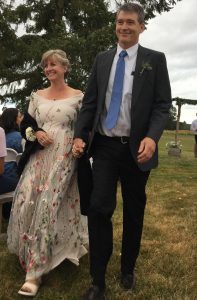Cidney Swanson's Blog
November 10, 2025
Speaking Elizabethan, As One Does
I speak Elizabethan. Okay, imperfectly, and not as a regular thing, and probably it would be more accurate to say that I understand Elizabethan English.
So how did this happen? Was it gained through hours and hours of graduate-level work, resulting in an obscure degree?
Nope.
(Although I do have a VERY obscure advanced degree, and some day I can tell you all about it.)
I learned to understand the English of Shakespeare as a kid, in the way kids learn any language: by being immersed in it. My dad was a high school English teacher who wanted to become better educated in his Shakespeare. Thus, when I was a baby, he and my mom began an every-summer habit of taking the fam to Ashland, Oregon to watch plays.
(Or, as the Elizabethans would have said, to “hear” plays.)
For several years, that meant date night(s) for my parents while my grandparents watched me and my younger sister. Children had to be five years old to attend performances. Mom and Dad waited for my younger sister to collect the correct number of birthdays, and thus I was newly seven by the time I attended my first Shakespeare play.
Do you know what seven-year-olds are really good at? Language acquisition.
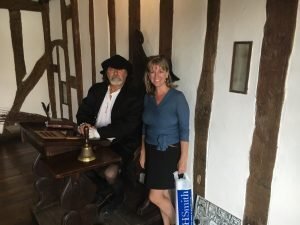
Me, visiting Shakespeare’s ACTUAL school room.
In my case, I was a LANGUAGE-OBSESSED child. I loved words. I loved sentences. I loved repeating words, memorizing things, trying on new accents – “Words, words, words,” to borrow from a sad Danish prince given to monologuing.
For instance, when I was two, I learned that you could express the concept of “two-ness” in three distinct ways. You could hold up two fingers in answer to the question “How old are you?” Or you could spell it using sounds (tea-double you-oh). Or you could speak the word “two.” I have a memory of walking down the hallway repeating “t-w-o” over and over, just waiting for someone to ask me how old I was.
Anyway, back to being seven and going to a play for the first time.
Now, if I’m honest, I don’t know if I saw Rosencrantz and Guildenstern are Dead first or The Merchant of Venice. We watched both that fateful summer. But if you know the Stoppard play (R&G), you know his language is extremely complex, and at times, Elizabethan. It was basically like seeing 2 plays in this new language.
I. Was. Smitten.
I had not been told ahead of time that Shakespearean dialogue was challenging. Of course, when you’re seven, all adult conversation is challenging. So I just leaned forward (careful not to touch the wimples of the nuns seated in front of me even though I REALLY wanted to) and listened.
Intensely listened.
IIRC, my sister fell asleep, but me? I was there for it! And when Portia and Nerissa told their betrotheds a Big Fat Lie, I was there to call them on it.
Literally.
I said, “Liar” from my back-row seat in the Angus Bowmer Theater, which for its time was innovative in how it allowed small sounds to travel great distances.
First the nuns in front of me tittered. One turned and smiled, so I figured I wasn’t in too much trouble? Then the next row started laughing, and the next, and next, in this speedy ripple of laughter that made it all the way to the stage.
At this point, the actors broke character. They started laughing, leaned down, braced their hands on their tights-clad thighs, and laughed. My parents were too mortified (amused? shocked?) to say anything to me.
The actors collected themselves and the scene continued.
As an adult reader of Shakespeare, I have searched for the line that says, “We’ve been faithfully staying at home praying for your return,” but that line, as such, doesn’t exist. Which means I was relying on context to understand what was going on, and who was fibbing.
From that summer forward, I BEGGED my parents to take us back for more Shakespeare. I watched plays on TV. I found the volumes of Shakespeare in the Great Books of the Western World collection and started reading. The spelling! The language! The everything!
All this to say, if you have ever noted the little nods to the bard in every novel I write, now you know where it all started….
Recently, I got to enjoy my favorite day, a recurring day that only happens once every two years. (Very Marsian, right??)
On this Day of Days, I get to deliver the All About Will Shakespeare lecture, providing students some context for the cultural setting of his plays. I always include ask-me-anything time because it is fun to see if the students can stump me! (It’s rare and thrilling when it happens, because it is essentially permission to do MOAR RESEARCH. Special interests, baby!)
So there you have it: the story of Cidney and the New Language. Btw, if you’re a language/word/bard nerd too? I need to know this!
For now, to tweak a quote from the conclusion of a play I love: “[I] this way, you that.”
Do you know which play it’s from?
October 11, 2025
Asking the Right Question, Asking the Wrong Question
While I was at sea for my writing cruise, I reflected an awful lot on questions. The more I thought about it, the more I came to see that, as an author my job is all about moving a character, in a compelling way, from asking the wrong questions to asking the right questions.
Let’s look at an example. I’ll use my SAVING MARS series. That series has so many characters with whom I can contrast Jessamyn, my main character. We can take a quick look at three of the “contrast characters”: Harpreet, Ethan, and Kipper.
Harpreet doesn’t have much of a growth arc, because when we meet her, she’s already done the hard work of becoming who she was capable of becoming. She has, in essence, learned what the guiding question is for her life. She faces her circumstances with this simple question, “Will it bring cheer or ease the burden of those around me?” From donating her precious store of tea in book one to refusing to be “rescued” from New Timbuktu prison in a later book, this query is her pole star.
Ethan, likewise, has done much of his work. He filters everything through this question: “Will it help the people of Mars?” In some ways, this makes him very similar to Kipper, although she has more of a growth arc, I would argue. So what is Kipper’s filtering question at the beginning of the series? Easy: “Will it help Mars Colonial?” There is a subtle difference between her question and Ethan’s. Ethan is more focused on individuals rather than “humanity.” Kipper’s growth arc consists of shifting from her question toward Ethan’s question. Her final act in the series comes from this shift. That is, she is able to act as she does because she has finally learned to care about individual Marsians, as opposed to the vaguer concept of “Mars Colonial.”
And this brings us to Jessamyn.
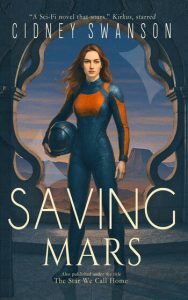
“Get me in a cockpit!”
In book one, she’s got a pretty basic question, which drives her forward through the first half-ish of the book. “Will it get me back in a cockpit?” Everything she does is about getting back in the air. After six books of growth and change, however, her final question becomes other-centered: “Will it save my people?” It is this question which leads her to walk straight into Lucca’s trap, knowing full well it is a trap, because trap-or-no, it is also the only way to save her people. Same person, different trajectory. You can even see it in the cover images!
So there you have it. If you are a writer and find yourself struggling to understand your character or to find their motivation, you might see if you can figure out what question guides their every move. And this might help you to figure out what trajectory you are most interested in sending them on!
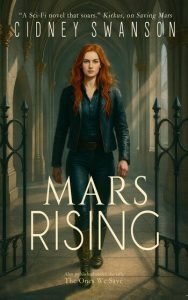
“Imma walk into a trap!”
November 26, 2024
How did I manage 3 days without a phone?
Three days without a phone? What? Seriously? Is that even possible in the modern world? I’ll tell you how it went…. But first I should probably explain how I came to be cell phone-less in the first place.
It would make me sound very cool if I said this was some sort of planned connectivity fasting period. It was not.
I most definitely did not plan to have my phone fall out of – but I’m getting ahead of myself. Three weeks ago, I rose very early in the morning to drive with Dr. Science up to Portland to catch a flight. We had a lovely empty-freeway drive and arrived in plenty of time for me to check my bags.
And that was where the trouble started.
It’s been awhile since I posted a pic of how I normally travel, but let’s just say that I never, never check bags, and that I’m very skilled at filling every square centimeter of my European-size carryon bag, even when I’ll be traveling for weeks on end.
This time, however, I had a little signing event to set up.
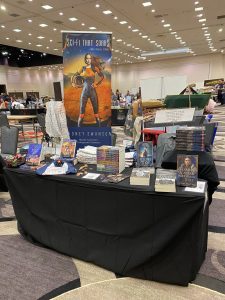
And that meant packing two suitcases that weighed … a lot. So Dr. Science sees a curbside check-in for Southwest and pulls up and we hand over my bags. And the sky-cap asks if I would like a printed boarding pass, and I think WHY NOT? How retro, how fun! A paper pass instead of using my phone!
So I say YES which means that when I go through TSA, it does not occur to me to whip out my phone. I just scan my (paper) boarding pass and I’m on my way.
It’s while I’m waiting at the gate that I realize I don’t have my phone. It takes me a good ten minutes to work up the courage to ask a total stranger if I could use their phone to call Dr. Science, and by this time he’s thirty-five minutes south of PDX and can’t get back to me before my plane leaves. But he confirms that, unfortunately, my phone is in the car, having fallen out of my pocket with neither of us noticing.
We agree I’ll catch my flight and figure out the phone situation later. (Seventy dollars later, as it turned out. But I digress.)
So what was it like not having a phone for three days?
My first taste of cell-phone-free me was when a fellow passenger on the flight came up to me and said, “Hi, I didn’t mean to eavesdrop, but I heard you, and I just want to say that you are now my example of how to remain calm in a stressful situation.”
I smiled and thanked her, thinking: I’m calm. I’m so calm that complete strangers tell me I am their role model. Wow. Maybe this will be a super-cool Zen-like experience after all!
So. Was it amazing and calming and all those things that are supposed to happen when we unplug?
I’m sorry to confess that it was not. Not even a little. I needed OTP’s (one-time passwords) at least six times in the first 24 hours, and it only got worse as entities with which I needed to do business flat out refused when I couldn’t provide the OTP. I can only say that while it might be a peaceful and calming experience for some to be parted from their phones, I am NOT among their number.
So there you have it. Me, not chill, not soaking in the vacay from the digital world. At all.
I flew on Sunday and I got my phone back on Tuesday, and I was very, very, very happy.
Here’s a picture taken of me the moment UPS delivered the package.

So even though some people might have a great experience cutting the cord, well, the picture says it all.
Now, as for that signing event? It was all kinds of wonderful. I hadn’t done one since pre-Covid, and I’d forgotten how fun it could be to chat with new and old fans. <3
Wishing my American readers a very happy Thanksgiving, with exactly the amount of cell service that makes you calm and happy.
October 13, 2024
How Many Revisions??
I was asked a question about my writing process last month, and it got me thinking. (“A dangerous prospect; I know.”) Here was the question: how many revisions are normal for me when I’m working on a novel?
The answer is: a lot.
More than one or two. Or three. Or four. I am absolutely not one of those writers who can pound it out and get it right the first time. Nor am I one of those who can, by going at a snail’s pace, say what I want to say the first time I make the attempt. Fortunately, I actually like revision. Mostly.
For me, the steps go like this:
1) First draft: pretty much what it sounds like. This is where I get the bare bones of the story down.
2) Read the first draft (after stepping away for a week-ish) and decide that it is terrible. Like, really terrible. I probably shouldn’t even bother continuing.
3) Tell Dr. Science my dilemma, namely, that I have written dreck. (He tells me that I always say this, and that I should continue.)
4) Attack the story, looking for ways to make the dreck a little less awful. Change up a dull talking-heads scene into an action-packed, danger-laden scene. Repeat this a few times.
5) Attack the dialogue, trying to let my characters speak in their own voices, instead of in my (often pedantic) voice.
6) Ask Dr. Science to read it and give me notes, telling him that it is pretty awful and that he probably won’t like it, and that he might not even want to bother reading it.
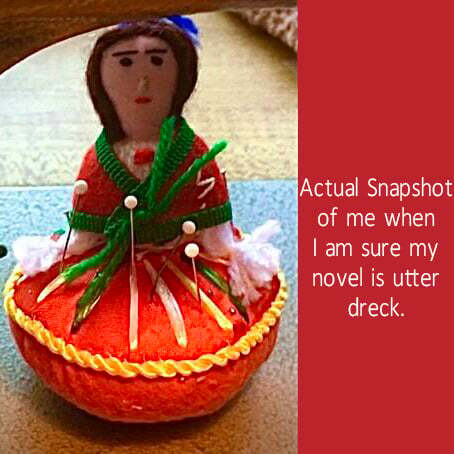
7) Read Dr. Science’s extensive notes. Despair. Take heart. Begin another revision. Read the revision and decide it still needs work.
8) Revise again, changing key scenes, dropping huge chunks of writing that just. Isn’t. Working. I think cutting 24,000 words is my record?
9) Read the revision and conclude that I have lost the ability to tell a story well. Complain to Dr. Science, he of the long-sufferingitude, that I can’t tell a story anymore.
10) AFTER Dr. Science has talked me off the ledge, reminding me that I say this about EVERY book I have ever written, start revising again. (“Once more unto the breach!”)
11) At this point, I often start liking the story. And start seeing ways to make the action and suffering more compelling. I complete another thoroughgoing revision. Possibly an editor will see it and give thoughtful, inspiring notes. ;o) Which I act on.
12) Now I’m ready to edit on the sentence level. Does every sentence follow logically and clearly from the one that preceded it? Are there things I’ve left out that the reader will need to know? Is the romance sufficiently angsty while also remaining sweet and awkward and all the things a Cidney Swanson romance is known for?
13) FINALLY, I am ready to do a copyreading revision, searching for “the the,” overuse of “that,” overuse of adverbs, adjectives, and repetitious repeatings that readers don’t need because they are smart like that.
14) Proofread this final version. Then hand off to proofreader.
So that’s it, basically. Then, about 4-7 days later, I rouse myself from a stupor and start in all over again on the next book.
Honestly it is a miracle on the level of the Bernoulli Effect that any of my novels are ever published. 
July 15, 2024
Highlights, lowlights, and … headlights?
I’m back from my all-too-quick visit to the UK last month. I re-visited Cornwall and Stratford-upon-Avon, doing a little research along the way! Here are the highlights:

Things look really good in pictures. I would LOVE to live my life there, in all those great moments. Look! Shakespeare’s schoolroom! Look! School boys walking there because it is STILL a school, and how cool is that? Look! Wildflowers! Timber-frame buildings! The ocean!
My trip wasn’t solid goodness, actually. I neglected to snap pictures of me, pulled off the motorway when the oil light on my rental car lit up 30 minutes after I hired it. No screen shots of my purchased phone minutes vanishing while I waited on hold for the car hire agency to take my call. And definitely no pictures of me sobbing when they said it might take two hours for help to arrive. (Happy spoiler: it took 20 minutes.)
Frank from Roadside Assistance met me with a huge grin and fixed everything. Having finished with my car, Frank could have zipped off to his next rescue. I mean, he did, but not before giving me a direct number to call if the car had more issues. And then he said, very kindly, “I want you to have confidence in your little Vauxhall Corsa. It’s a good car.”
It’s hard to explain what those words did for me. I mean, I can sort of explain. I’d been given a rental vehicle WITH NO OIL IN IT. While driving in not-my-own country. I’d lost 90 minutes on the side of the road. I’d burned through my phone minutes. There was no confidence. Confidence was not happening. Except Frank from Roadside Assistance said, “I want you to feel confident….”
I tucked those words in my pocket.
I repeated them as I drove down B roads where there wasn’t room for two vehicles to pass. And when I did a twenty-seven-point turn (maneuver?) into a teensy-weensy space at St Ives. And when I drove into S-u-A at rush hour and had to make repeated right-hand turns across oncoming traffic. The kindness of Frank made a ginormous difference. I had confidence in my little Corsa.
I write characters who are like Frank (looking at you, Harpreet and Sir Walter), but I don’t expect to meet them in real life when I’m in semi-crisis driving on the wrong side of the road. Erm, I mean the “other” correct side of the road. Maybe I should have taken pictures of my car with its hood/bonnet wide open! (Would you??)
Anyway, I hope you’re having a wonderful July, with zero roadside drama. But if your car runs low on oil, then I wish you a Frank.
February 24, 2024
For My Writerly Readers Who Write
Like most writerly types, I am wordy. Verbose. When two words will suffice, I am likely to use twenty-six. Or two hundred. Or two thousand. (See what I did there?) (And here?)
I have a way of tidying up these (unnecessary) words that I’ve never heard anyone else suggest, and I want to share it.
Though I always try to remove the deadweight during one of the final revisions, I will often find myself with a larger word count than is ideal. Here’s how I tackle it: by deciding what final word count would make me happy, and evenly removing the words from each page.
That means that if I have an 85,000 word manuscript, and I want to get it down to 78,000, I will need to remove 7,000 words. If I have 365 pages, then I need to take out an average of 19 words per page.
I do this rigorously. If I have only removed 15 words, I start back at the top and look for 4 more. And here’s the thing: with VERY FEW exceptions, I can always find them. I keep track by writing the number on the back of the page I’ve just edited. If I found 19, I write “0” on the page. 25? I write “-6” because I have exceeded my number and removed 6 extra words. Yay! But if there is a page where the tension is already super tight, and I just can’t take out 19 words, I am okay removing what I can. If I remove 8 fewer than 19, I would be 11 words behind on my ideal count. So I would write either “+11” or if I were adding it to the previous “-6” page, I would write “+5” because I’m really only off by 5 excess words.
The amazing thing is that even when I’m sure a manuscript is tight, tight, tight, I can always find words I don’t need. The end result is a manuscript that is tighter, lighter, and cheaper to turn into a book. Yay!
This really hit home for me at a recent writing retreat, where an agent and an editor were both commenting on how they feel pressure to keep word counts low because of spiraling printing costs. (This would affect audiobook production as well, obviously. And copy edits and line edits and …. you get the idea.)
Here are the quick and dirty ones you can look for:
Create contractions for EVERYONE who would speak with contractions. (Could’ve for could have)20 years becomes “decades”in five hundred years = “in five centuries”finding out = “learning”it does not matter = “it’s irrelevant”I grab a Frisbee and send it sailing toward her = I send a Frisbee sailing toward herGet rid of adverbs! “my arms snake tightly…” = “my arms snake”Get rid of modifiers in general! “says my mom” = “says Mom”I hope this helps anyone who has a too-high word count. Er, make that “wordy manuscript”!
(Got a go-to? Share it in the comments!)
January 3, 2024
Eleventh Hour. Erm, Chapter. (Tsaritsa, Scholar, Woodsman, Thief)
Chapter Eleven
Diogenes and Astrid had at long last reached the duke’s cottage, where they would rest for the night. Diogenes set to, securing their belongings against foul weather. The not-princess herself saw to the horse, having explained that she loved such work.
Astrid was much pleasanter company than Diogenes had bargained on. He would never have taken her for someone who knew her way around horses, but she had removed its harness aright and asked for its brush, and Diogenes had surrendered the horse to her care.
He was thus the first inside the cottage. He found a simple clay oil lamp and struck flint against pyrite stone until sparks caught a small piece of straw on fire. This, he used to light the flaxen rope within the lamp. It sputtered to life, casting long shadows in the small cottage. He was finishing the lighting of two additional lamps when the girl came inside, announcing that the horse had been watered and secured for the night.
“This place is like a small storehouse,” said the girl, looking about.
Diogenes, too, had marveled at the rows of small barrels and stone jars that filled two of the walls of the dwelling.
“I suppose that if Lord Bartholomes were caught unawares by snowfall, he could last quite a while here,” said the girl. “Now, which of these barrels has that honey cake you promised? I can make nothing of your Rosiyska alphabet.” As she said this, she drew a finger along the curved lettering that indicated a barrel of dried fish.
“Let me see,” said Diogenes, making his way along one of the shelves.
“Oi!” cried the girl.
Diogenes whirled to see what was amiss.
“I think it’s dead,” she said.
“You think what is—” Diogenes broke off as he spied a dead rat near the girl. “Oh. Yes. Very dead.”
“There’s another over here,” she said, pointing.
“And a dead mouse in this corner as well,” said Diogenes, now intently observing the floor.
“How very unpleasant.”
“I’ll take them outside, shall I?”
“Oh, I can do it,” replied the girl. “I can’t read the labels on the food, so you must do that. I shall do … this.”
Diogenes nodded, pleased the girl was not squeamish. Searching a high row, he located a container marked “cake” and lifted it down from the shelf.
On opening it, however, he released a curse and hurriedly replaced the lid.
“What is it?” asked the girl, who was gathering the dead rodents into a linen sack.
“The food inside is spoilt,” said Diogenes. “I shall find another.”
“Spoiled how?”
“Rodent droppings and … and a mouse in an unpleasant state of decay.”
He reached for another barrel marked “cake.” On opening it, however, he found more evidence of visitation by rodents.
“Lord Bartholomes ought to have been more careful choosing whoever was tasked with sealing his stock of food,” remarked Astrid.
“This one looks well enough,” said Diogenes.
He reached inside to remove the cake for further inspection.
“We can eat this,” he said, after undoing its brandy-soaked linen wrap.
“Diogenes …”
He looked up and saw that Astrid’s face had gone pale and worried.
“What is it?” he asked using his knife to slice a large piece from off the cake.
“Do not eat that,” said the girl.
“What do you mean? Why ever not?” He cut a slice for the girl.
“The rats. The mice. Why should they have died in a room full of food?”
Diogenes shrugged. He brought the slice to his mouth.
“No!” Astrid batted the sliced cake, and it fell to the ground.
“Now look what you’ve done,” muttered Diogenes.
“I think the food must be unwholesome. Outside, when I went to … to dispose of the dead creatures, I found several more outside, also dead.”
Diogenes’ stomach rumbled loudly. “It doesn’t look unwholesome,” he said, eyeing the second slice of cake.
“Doubtless the mice and rats thought the same thing.”
Diogenes set the slice down. “It is odd,” he admitted. “Rodents dead inside a cottage stuffed with food?”
“I think we should not eat anything from inside this cottage,” the girl said nervously.
Diogenes exhaled heavily. “Well, there is the rest of the cake in the cart, and I suppose I could catch a fish or two from the lake.”
They exited the dwelling together. Outside, daylight was fast disappearing, and the whine of small insects left the two swatting at real and imagined pests. It was a good hour for fishing, however, and within a few minutes, the two were seated on a rock at the lake’s edge, eating bites of fruited nut cake and seeking a fish to round out their supper.
Because of the darkness of the hour, neither of them recognized the water worm for what it was when it raised its dripping head to stare at them from the lake’s watery depths.
October 16, 2020
Failing Onward!

I’m writing this down in hopes it will inspire anyone needing that push to keep trying for success on a difficult task/project/dream. If you’ve seen the video about making The Wedding Gown for the daughterling, then you know I met the deadline and gave my daughter a gown that was absolutely perfect for her. It wasn’t a huge challenge, because I have the background in pattern-making and costume design. I started patterning in December and slowly worked my way through sourcing fabric, perfecting the fit of the pattern in a “muslin” (fake fabric), buying and cutting the real fabric, sewing the gown, cutting up the lace embellishment, mosaic-ing the lace pieces to fit onto her bodice, embroidering crystal beads and pearls onto the lace, and attaching the lace to the gown. I would do about an hour’s worth of lace embroidery each night watching TV. (Inspector Lewis, Endeavor, and Upstart Crow, mainly.)
As July 6th drew near, I knew I would finish her gown in time, so I started thinking about my own Mother-of-the-Bride gown. I had maybe a month to go till the wedding. I didn’t think I wanted to make my dress, but once I went to stores, I realized I DID want to make it myself. So I went to Joann and found possible fabrics and then went home to try to make a pattern I liked.

I decided to make a full “muslin” dress for myself, since I wanted to be sure I liked the shape before committing to buying spendy fabric. I wanted a stretch fabric, so I couldn’t use actual muslin, which doesn’t stretch. Instead I used this old printed knit from my kid’s clothing business days, green with blue tree frogs all over it.
I patterned it, cut it, sewed it, and tried it on.
Ugh. Not even.
The problem wasn’t the tree frog fabric; it was the fit of the garment. I felt super yucky in this design. Not the feeling I was going for. At first I thought, well, that’s it. I have to buy something off the rack. Hmm . . . what stores can I hit up next? But when I tried (again) to find a gown in stores, I failed, again. Fine. Maybe I could try another style of pattern?
After searching all my closets for styles I had worn and liked in the past, I chose a dress that had belonged to my great grandmother Pearl, circa 1960, and decided this was it! Retro-chic and flattering. So I started from scratch again, copying the pattern off the actual dress and making another mock-up muslin, this time in slinky woven polyester. When I tried on this new muslin, it was even worse than the tree-frog disaster.
Now what was I going to do? The wedding was in two weeks. I hit the mall again and found two possible dresses at Macy’s, and I brought them home. Neither was really right, though, and as Wedding Week approached, I got more and more unhappy thinking of how the pictures from the wedding would show me wearing a dress I didn’t like.
The problem was, I’d already failed twice to make something for myself. 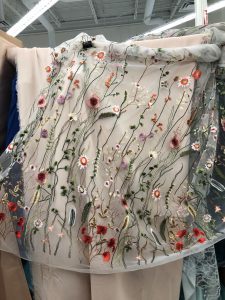 I decided to try one final time, because really, what did I have to lose? I would go with a simpler pattern this time, and see how far I could get. Meanwhile I’d found a fabric that I was completely head-over-heels about, so that gave me a bit more motivation.
I decided to try one final time, because really, what did I have to lose? I would go with a simpler pattern this time, and see how far I could get. Meanwhile I’d found a fabric that I was completely head-over-heels about, so that gave me a bit more motivation.
I cut and sewed my THIRD muslin, and managed to pin, cut, and adjust the front pretty well for a good fit, but I couldn’t reach around my back, obviously. Enter Dr. Science. I showed him the part of the muslin that wasn’t fitting well in back. He agreed. “Yup, that isn’t fitting well. What do you want me to do about it?” It took a few minutes and a small compact mirror held over my shoulder in front of the bathroom mirror, but I finally managed to explain to Dr. Science how to pin the not-fitting part so that it would fit more smoothly.
It took two more muslins to get the fit just right. (Off the shoulder is a little trickier than on.) But the third time I got it! My pattern fit beautifully! I was ready to go! I started cutting and sewing. The wedding was in five days, and believe me, I had more things to do than just sit and sew. But, by keeping at it, a little here a little there, I managed to finish the gown in time.
It is my all-time, favorite gown/dress/anything that I have ever worn. I came so close to giving up and buying a dress I didn’t like, and I’m soooooo glad I didn’t. How many favorite dresses do you really get in a lifetime? (My last one was a dress made by my grandmother Dorothy when I was six or seven. Emerald green taffeta covered with all-over lace.) Thank goodness I didn’t give up.

I started by saying that I was writing this in hopes it might inspire others to keep going on hard projects, but maybe I’m just writing it so I don’t forget the lesson myself. Fail all you need to—just don’t quit.
April 19, 2020
How Astronaut Scott Kelly Handled Isolation (And You Can Too)
The week before last, I had the incredible privilege of being on a Zoom call with Astronaut Scott Kelly, who stayed on the International Space Station for just shy of a year. There were only fifty or so of us on the call. I really hope he can share his thoughts on isolation with a wider audience, but at the bare minimum, I felt like I needed to share some of the ways he said he coped, because they’re applicable to our situation today with the Covid-19 lockdowns in place.
 A little background first. Kelly had been to space a couple of times already, including one six-month stint on ISS. Because of the level of isolation he experienced on that extended stay, Kelly told us he nearly turned down the twelve-month opportunity. In the end, he decided to go, but he said that he planned for it in a very calculated way.
A little background first. Kelly had been to space a couple of times already, including one six-month stint on ISS. Because of the level of isolation he experienced on that extended stay, Kelly told us he nearly turned down the twelve-month opportunity. In the end, he decided to go, but he said that he planned for it in a very calculated way.
Whereas he’d kept careful track of how long he was up on the shorter stint and how long he had to go, Kelly chose not to pay attention to either of these for the longer stint. That became tip number one for those of us on the call. He feels that you can drive yourself crazy trying to figure out “how much longer” this will last. He also mentioned that the twelve-month stay felt shorter than the six-month stay. Seriously? Shorter?
Okay, he had our attention. So what else did he recommend? He stayed very scheduled on his second stay, which is probably true for anyone on ISS, but he did it a little differently the second time. He made sure that his weekends looked different from his weekdays. This provided him with something to look forward to–other than his eventual return from isolation. By having Saturday as “tidy things up” day, it felt different from the weekdays. He recommended for those of us at home now that we add something we enjoy to our Saturday routines. Tidying, a walk, a special meal, a movie you’ve looked forward to, and so on. He also kept Sunday different, spending a long time in the cupola gazing at Earth as it rotated past.

At this point, all of us on the call were like, “Where’s my cupola? I want a cupola view of planet Earth!”
Kelly went on to explain that in his Houston apartment currently, he and his wife make Sunday different by watching a lot of content on Netflix. He also said that spending time on his balcony provides him with a break from being stuck inside.
I started feeling very, very grateful for my ordinary suburban yard.
So there you have it. (1) Don’t try counting how long it’s been/will be. (2) Keep busy with a weekday schedule. (3) Make Saturdays and Sundays special so that you always have something nearby that you can look forward to.
I’ve been practicing these things for almost two weeks now, and I’ve gotta admit, it’s helping. A little. But we’ll take what we can get, right? I’ve never been good at tidying, and I actually spent several days looking forward to doing some cleaning the past two Saturdays.
I really hope this helps some of you. Oh, and besides helping me with tips I could use, Kelly’s talk also cured me of wanting to spend an extended period of time aboard ISS. I wouldn’t turn down the chance to experience micro-gravity for a shorter time though. Right?
July 20, 2019
FAILING ONWARD
I’m writing this down in hopes it will inspire anyone needing that push to keep trying for success on a difficult task/project/dream. If you’ve seen the video about making The Wedding Gown for the Daughterling, then you know I met the deadline and gave my daughter a gown that was absolutely perfect for her.
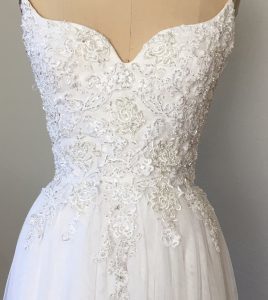
That wasn’t the challenge I’m writing about today. I had the background in pattern-making and costume design to nail Daughterling’s gown. I started in December and slowly worked my way through sourcing fabric, perfecting the fit of the “muslin” (mock-up), patterning, cutting the real fabric, sewing the gown, cutting up the lace embellishment, mosaic-ing the lace pieces to fit onto her bodice, embroidering crystal beads and pearls onto the lace, and attaching the lace to the gown. I would do about an hour’s worth of lace embroidery each night while watching TV. (Inspector Lewis, Endeavour, and Upstart Crow, mainly.) Easy-breezy.
As July 6th drew near, I knew I would finish her gown on time or early, so I started thinking about my own Mom-of-the-Bride gown. I had maybe a month to go till the wedding. After visiting stores, I realized I would have to make mine to be happy with it.
I decided to make a full “muslin” for myself, since I wanted to be sure I liked the shape and style before committing to buying spend-y fabric. I used this old print fabric from my kid’s clothing business days, pistachio green with blue tree frogs all over it. I patterned it, cut it, sewed it, and tried it on.

Ugh. Not even.
The problem wasn’t the tree frog fabric; it was the fit of the garment. I felt super yucky in this design. Not the feeling I was going for. At first I thought, well, that’s it. I have to buy something off the rack. Hmm . . . what stores can I hit up next? But when I tried again, I failed again. Fine. Maybe I could sew another style?
After searching all my closets for styles I had worn and liked in the past, I chose a dress that had belonged to my great grandmother Pearl, circa 1960, and decided this was it! Retro-chic and flattering. (Full disclosure: I’m not that size.)
So I started from scratch again, copying the pattern off the actual dress and making another mock-up muslin. 
When I tried on this new muslin, it was even worse than the tree-frog disaster.
Ugh!
Now what was I going to do? The wedding was in two weeks. I hit the mall again and found two possible dresses at Macy’s, and I brought them home. I didn’t love either, and as Wedding Week approached, I got more and more unhappy thinking of seeing that dress whenever I looked at pics from Daughterling’s wedding.
But . . . I’d already failed twice to make something for myself. When I’m making a costume/gown/pattern for someone else, I can do all the pinning and adjusting, and this means it turns out perfectly, albeit with tweaks. When making something for myself, I couldn’t do all that pinning and adjusting.
Or could I?
I decided to try one final time, because really, what did I have to lose? (I can be really, really stubborn.) I would go with a simpler pattern this time, and see how far I could get. Meanwhile I’d found a fabric that I was completely head-over-heels about, so that gave me a bit more motivation.
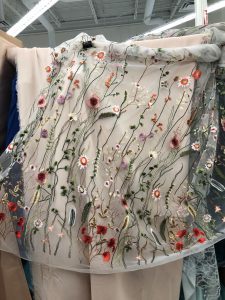
I cut and sewed my THIRD muslin, and managed to pin, cut, and adjust the front pretty well for a good fit, but I couldn’t reach around my back, obviously. Enter Dr. Science. I showed him the part of the muslin that wasn’t fitting well in back. He agreed. “Yup, that isn’t fitting well. What do you want me to do about it?” It took a few minutes and a small compact mirror held over my shoulder in front of the bathroom mirror, but I finally managed to explain to Dr. Science how to pin the not-fitting part so that it would fit more smoothly.

It took two more muslins to get the fit just right. (Off the shoulder is a little trickier than on the shoulder.) But the third time I got it! My pattern fit beautifully! I started cutting and sewing. The wedding was in five days, and believe me, I had more things to do than just sit and sew. But, by keeping at it, a little here a little there, I managed to finish the gown in time.
It is my all-time, favorite gown/dress/anything that I have ever worn. I came so close to giving up and wearing one of those dresses from Macy’s, and I’m soooooo glad I didn’t. How many favorite dresses do you get in a lifetime? (My last one was a dress made by my grandmother Dorothy when I was six or seven. Emerald green taffeta covered with all-over lace.) Thank goodness I didn’t give up.
I started by saying that I was writing this in hopes it might inspire others to keep going on hard projects, but maybe I’m just writing it so I don’t forget the lesson myself. Fail all you need to—just don’t quit. Even if it means a doggy-looking tree frog dress or two.
(The finished product:)
